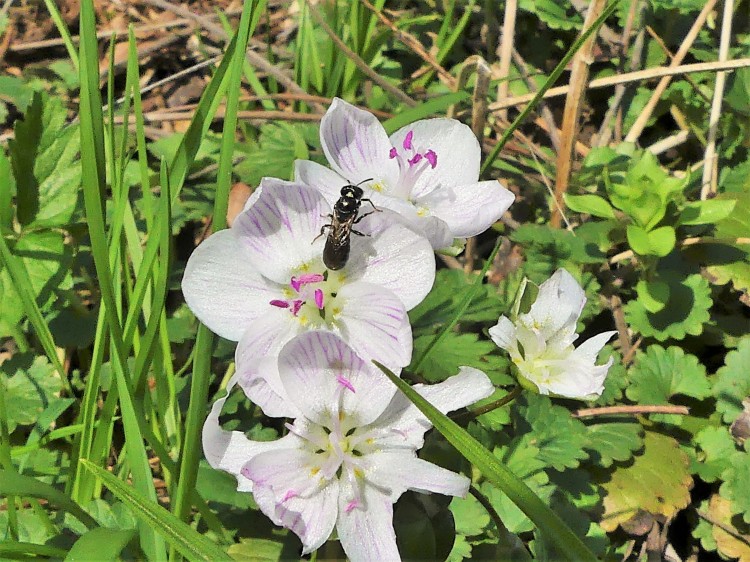
The blogger apologizes for the dearth of blog posts lately, but she has been busy with the important work of wildflower revival. Which is of course one of the topics that makes this blog worth writing. The Spring beauty, Claytonia caroliniana wildflowers in the above image were settled into their new home last spring, moved from a place where they had much company to a site that was quite lacking in spring ephemerals.

This is the location of their new home, and each year they get more little clumps of their kind for company. Passing this spot yesterday at 2:00, when it was sunny and in the mid 70’s, I noticed a good bit of small insect busy-ness around the blooms.

A closer look revealed more than one species of native mining bee hovering close to the flowers. Though my images show them nectaring or gathering pollen, very few were actually doing this. And some that did land, were instantly knocked off the flower by another bee! What was going on here? I suspect I was spying on a singles party, the male participants eagerly vying with each other to hookup with the females.

This is the role of spring ephemeral wildflowers – to provide nectar and pollen to early butterflies, bees and flies in return for pollination. Some mining bees have evolved to specialize in one species of spring ephemeral – most of the bees clustering around the blooms appeared to be the Spring beauty miner bee, Andrena erigeniae.
These two great links have close-up images and info about life cycle of this bee:
https://springbeauties.wordpress.com/learn-the-pollinators/andrena-erigeniae/
http://bugoftheweek.com/blog/2015/5/4/spring-beauties-mining-bees-iandrena-erigeniaei

Spring beauties have small abundant blooms over a relatively long period so are ideal for the needs of tiny mining bees. I learned the male and female bees look different; females are more hairy, males have longer antennae. Males only seek nectar, but once females have mated they will gather pollen for their undergound egg chambers. The bee in the image probing the flower’s nectaries is likely a male.

The blooms vary from pure white to candy pink, but all have the distinctive “nectar guide” stripes.

A closer look at this flower reveals the bee is a different species, likely the Pure golden green sweat bee, Augochlora pura, which nests in rotten logs.

Though every year there are more spring ephemerals in this forest, the fact remains that most areas are still lacking. The rich soils and leafy duff of the Spicebush patch in the image above are an ideal site, yet it currently supports very few wildflowers. Historical land uses, particularly deforestation and long term grazing caused much of the damage, then decades of heavy spring shade from invasive Bush honeysuckle finished the job. Though hardy in many ways, spring ephemerals don’t just pop up from seed – most spread slowly through expansion of their rhizomes or corms. The areas where they’ve been lost will probably never see their return unless they’re replanted.
The Forest Stewards will prioritize transplanting and planting bareroot ephemerals in the coming years, on favorable sites where no invasive plants remain. The few remaining historical patches on steep hillsides and in rich drainages suggest what a wildflower paradise this forest once was. Hopefully, someday, spring ephemerals and their insect companions will be abundant again at Beargrass Creek SNP.

shoreacres
I loved seeing the photos of the flowers as well as those of the insects. I’ve never seen Claytonia caroliniana in person, but I do receive the newsletter of the Arkansas Native Plant Society, which just happens to be named The Claytonia.
There was quite a bit of concern about a late emergence of spring flowers after our historic ice and snow, but things seem to be working out. Crow poison and dewberry blossoms arrived en masse first; now, introduced plants like wisteria are helping, and the native wildflowers are showing their faces. Yesterday, I found a hillsides covered with bluebonnets, and believe me — the number of bees and flies were uncountable. Butterflies and skippers are around now, too. Yesterday I saw some Monarchs and swallowtails of various sorts.
I found another, unexpected treat: a beautiful beetle impaled on barbed wire. I’ll be posting that one — along with my suspicion that a shrike was in the neighborhood!
LikeLiked by 2 people
oneforestfragment
Claytonia seems so tiny and common here compared to the big showy wildflowers. But for the little mining bees it’s the best! Amazing to realize the abundance of wildflowers in bloom in your neck of the woods. No wonder Lady Bird J. was a wildflower enthusiast.
LikeLike